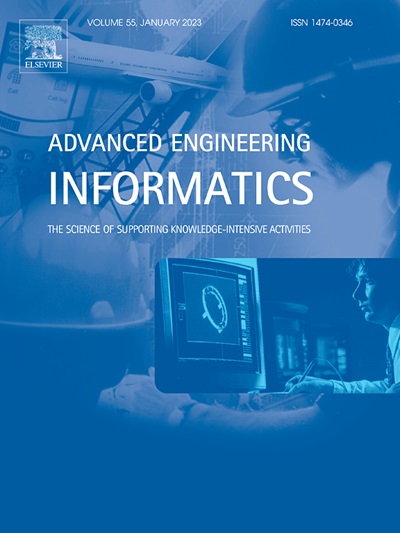Threshold alignment indicator driven two-phase nonlinear degradation model for remaining useful life prediction of rolling bearing
IF 8
1区 工程技术
Q1 COMPUTER SCIENCE, ARTIFICIAL INTELLIGENCE
引用次数: 0
Abstract
Wiener process has been widely used in remaining useful life (RUL) prediction studies of rolling bearing by virtue of the ability of quantifying the RUL prediction uncertainty results with the good interpretability and computability. However, the known failure threshold is required for the degeneration modelling of Wiener process. While, the scale drift of health indicator (HI) due to the various degeneration process caused that the preset failure threshold is unavailable, and current wiener-based RUL methods merely focus on the degeneration modelling, especially single-phase, which have seriously affected the RUL prediction results acceptance. To solve this problem, threshold alignment indicator (TAI) driven two-phase nonlinear degradation model (TPNDM) for RUL prediction of rolling bearing is proposed. Specifically, a method named gray relational analysis (GRA) of envelope spectrum singular value (ESSV) is designed to build TAI, in which ESSV is a novel transformed degradation feature space with robustness and trendability to reveal degradation information concealed within the raw vibration data, and GRA is conducted on ESSV to mitigate the scale drift of degradation among different rolling bearings and build TAI. The generated TAI can provide a unitive failure threshold for RUL estimation model and enhance the generalizability of the constructed TPNDM. TPNDM simultaneously considered the factor of nonlinearity, three-variability and two-phase to character the degradation path to enhance the prediction acceptance. Based on the proposed TAI driven TPNDM method, RUL estimation is completed by updating Bayesian criterion. Extensive experiments conducted on both public and industrial scene run-to-failure bearing datasets validated the superiority. These results from comparison experimental show that TPNDM improves MAE, RMSE and Score about 18.09, 21.91, 0.30 individually than some advanced methods, indicating that the proposed TAI driven TPNDM method has more prominent performance for RUL prediction.
滚动轴承剩余使用寿命预测的阈值对准指示器驱动的两相非线性退化模型
维纳过程由于能够对滚动轴承剩余使用寿命预测的不确定性结果进行量化,具有良好的可解释性和可计算性,在剩余使用寿命预测研究中得到了广泛的应用。然而,对于维纳过程的退化建模,需要已知的失效阈值。然而,由于各种退化过程导致健康指标的尺度漂移导致预设的失效阈值不可用,目前基于维纳的RUL方法只关注退化建模,特别是单相退化建模,严重影响了RUL预测结果的可接受性。为解决这一问题,提出了基于阈值对准指示器(TAI)驱动的两相非线性退化模型(TPNDM)进行滚动轴承RUL预测。具体而言,设计了包络谱奇异值(ESSV)灰色关联分析(GRA)方法来构建TAI,其中ESSV是一种新的转换后的退化特征空间,具有鲁棒性和趋势性,可以揭示隐藏在原始振动数据中的退化信息,并在ESSV上进行GRA以减轻不同滚动轴承之间的退化尺度漂移,从而构建TAI。生成的TAI可以为RUL估计模型提供统一的失效阈值,增强了所构建TPNDM的泛化能力。TPNDM同时考虑非线性、三变率和两相因素来表征退化路径,以提高预测的可接受性。在提出的TAI驱动TPNDM方法的基础上,通过更新贝叶斯准则完成RUL估计。在公共和工业场景运行到故障轴承数据集上进行的大量实验验证了该方法的优越性。对比实验结果表明,TPNDM方法比一些先进的方法分别提高了MAE、RMSE和Score,分别提高了18.09、21.91和0.30,表明本文提出的TAI驱动TPNDM方法在RUL预测方面具有更突出的性能。
本文章由计算机程序翻译,如有差异,请以英文原文为准。
求助全文
约1分钟内获得全文
求助全文
来源期刊

Advanced Engineering Informatics
工程技术-工程:综合
CiteScore
12.40
自引率
18.20%
发文量
292
审稿时长
45 days
期刊介绍:
Advanced Engineering Informatics is an international Journal that solicits research papers with an emphasis on 'knowledge' and 'engineering applications'. The Journal seeks original papers that report progress in applying methods of engineering informatics. These papers should have engineering relevance and help provide a scientific base for more reliable, spontaneous, and creative engineering decision-making. Additionally, papers should demonstrate the science of supporting knowledge-intensive engineering tasks and validate the generality, power, and scalability of new methods through rigorous evaluation, preferably both qualitatively and quantitatively. Abstracting and indexing for Advanced Engineering Informatics include Science Citation Index Expanded, Scopus and INSPEC.
 求助内容:
求助内容: 应助结果提醒方式:
应助结果提醒方式:


